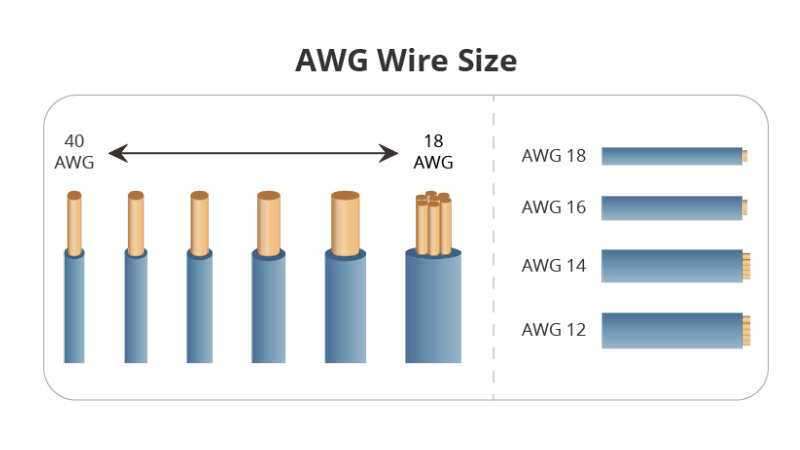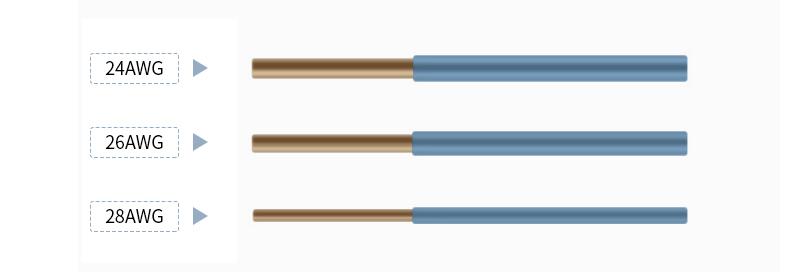Everything You Should Know About AWG (American Wire Gauge)
Ethernet cables are physical connectors that enable data transmission and Internet connectivity. Ethernet cables are used in various applications, from home networks to large data centers, and are essential to fast and reliable network transmission. While most of us are probably familiar with terms like Cat6 or Cat6a, wire gauge (commonly referred to as American Wire Gauge (AWG)) is often overlooked. If you have ever purchased an Ethernet cable, you will find that not only the length of the cable may vary, but also the specifications of the cable. Read this article to learn more about wire gauges.
American Wire Gauge Overview
What Does AWG Mean?
AWG stands for American Wire Gauge, a standard for measuring the thickness of wires and cables. It was introduced in 1857, replacing various measurement methods previously used by manufacturers. The AWG value indicates the diameter of the wire; smaller AWG numbers represent thicker wires with lower resistance. Regarding Ethernet cables, AWG specifies the gauge of the copper conductors within the cable.

The Application of Cable AWG
The significance of AWG lies in its role in ensuring the uniform production of electrical cables and related items, streamlining the process for consumers and businesses to identify suitable wires for their requirements. Moreover, AWG plays a vital role in assessing the electrical resistance of specific wires.
Hence, it emerges as an indispensable instrument for electricians and professionals involved in electrical systems. Given its extensive history and widely recognized reliability, American Wire Gauge continues to be an indispensable resource for anyone dealing with electrical wiring.
Individuals frequently employ AWG when selecting electrical wiring for residential or commercial settings. Electricians rely on it to guarantee the appropriate wire size for specific applications.
For instance, opting for a wire with a lower AWG rating than necessary can result in issues such as overheating and potential fires. This occurs because the wire must bear more current than its designated capacity, resulting in heightened resistance and heat accumulation. In severe instances, this overheating can lead to the wire igniting. Hence, utilising the thickest wire feasible when configuring an electrical system is advisable.
Does AWG Affect Ethernet Cable Performance?
First of all, the answer is Yes. It impacts the performance and suitability of Ethernet cables in several aspects:
Signal Quality
Thicker wires (lower AWG) typically have lower resistance, allowing them to transmit signals more effectively and reduce signal attenuation. This helps maintain better signal quality and lower error rates in data transmission. Conversely, thinner wires (higher AWG) may introduce more signal distortion, leading to degraded signal quality.
Heat
Thicker wires can handle power more effectively and generate less heat when transmitting current. For applications requiring significant power transmission, such as Power over Ethernet (PoE), using thicker wires can reduce the risk of overheating. On the other hand, thinner wires may generate more heat due to increased resistance, requiring better heat dissipation and airflow.
Airflow
Since thicker wires typically occupy more space, they may affect airflow within the cable. In environments where maintaining good airflow around the cable is necessary to reduce temperatures, thinner wires may be more suitable as they take up less space and allow for better airflow.
Space Utilization
Thicker wires occupy more space, so in some situations, such as wiring through smaller conduits or channels, choosing thinner wires may be more appropriate. Conversely, thicker wires may provide better protection in specific environments as they are generally more durable.
Common Wire Gauges Introduction: 24AWG vs 26AWG vs 28AWG
Most manufacturers use 24AWG or 26AWG Ethernet cables, while 28AWG Ethernet cables are becoming increasingly popular among users. I will describe them in more detail in the following.
How Can I Identify These Three Ethernet Cable Gauges?
Based on their appearances, distinguishing between 24AWG, 26AWG, and 28AWG cables is relatively straightforward.
AWG 24: 24AWG cables are notably the largest of the three. Most cables with this AWG size have solid cores, making them well-suited for longer distances.
AWG 26: 26AWG cables represent another commonly used cable size in the market. This particular AWG size is frequently employed in stranded cables. They contain slightly more copper than 28AWG cables and slightly less than 24AWG cables, rendering them an excellent option for short cable runs. Another prevalent application of 26AWG cables is their availability in shielded and stranded forms, such as 26AWG Cat6a patch cables and Cat6a bulk cables.
AWG 28: 28AWG cables are gaining popularity due to their thinner profile than standard Ethernet cables, thanks to the smaller wires inside. Typically, these cables feature stranded conductors. Their slender wires make them well-suited for shorter runs. Moreover, 28AWG cables are renowned for their flexibility, a crucial aspect for installations involving patch panels and networking enclosures. However, owing to the reduced amount of copper used in their construction, 28AWG cables may exhibit slightly diminished performance compared to 24AWG and 26AWG cables over longer distances.

AWG 24 vs AWG 26 vs AWG 28: Understanding the Wire Gauge Differences
The following table lists their main differences:
How to Select the Right Wire Gauge?
Based on the aforementioned variances, you now possess a foundational comprehension of Ethernet cable gauge. Your selection between 24AWG, 26AWG, or 28AWG Ethernet cables hinges on your precise networking requirements and application demands. In this segment, you'll receive targeted advice tailored to diverse scenarios, enabling you to make well-informed decisions regarding your cable purchases. Before making any decisions, consider the following factors:
Transmission Speeds
If you require high-speed data transmission over long distances or working with applications like 10GbE, 24AWG cables are a solid choice. Their thicker conductors offer lower resistance and support higher data rates.
Cable Length
When extended cable runs are required without compromising signal integrity, particularly for installations in sizable buildings or data centers, 24AWG is the preferred option.
Space Limitations
In instances necessitating shorter cable connections or where flexibility and space constraints take precedence, 26AWG and 28AWG are favored. The slender conductors simplify cable management.
PoE Power Capability
When simultaneously transmitting data and power through Ethernet cables, 24AWG cables excel at managing heavier power loads, which is essential for devices such as security cameras, access points, and phones reliant on PoE.
Budget Considerations
26AWG and 28AWG cables are frequently more affordable and easily accessible. When budget limitations are a factor, they present a cost-efficient solution.
Compare QSFPTEK Ethernet Patch Cables with Different Wire Gauges
QSFPTEK offers different types of network cables:
To learn more about Ethernet cables, you can contact QSFPTEK. We will provide you with cost-effective, high-quality copper cable solutions.
Conclusion
In summary, comprehending American Wire Gauge (AWG) is crucial for Ethernet cable users. AWG dictates wire thickness, impacting signal quality, heat generation, and space utilization. Thicker 24AWG cables suit long-distance high-speed transmission and heavy power loads, while 26AWG and 28AWG offer flexibility and cost-efficiency for shorter runs. Choosing the correct gauge depends on transmission speeds, cable length, and budget. Trusting reputable suppliers like QSFPTEK ensures optimal network performance and reliability.











